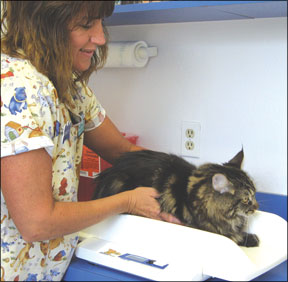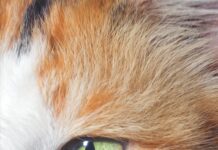Dear Elizabeth, I read the column about your weight problem a few months ago; how is your diet going? Ive tried to follow your advice when feeding my own chubby cat, Ernie, but am having a tough time. I calculated his daily calorie requirement as you suggested and split that amount between breakfast and dinner. But since I work all day I leave him a little extra dry food in a bowl for lunch. Its always gone when I get home so he must get really hungry during the day. Then, after he gobbles up his dinner hes okay until much later when he really needs a small bedtime snack. I know that his total calorie intake each day is more than the formula says he needs, but hes so hungry! How have you managed your appetite?
Thanks so much for asking about my diet. I must say that I look fabulous. Those few pounds Ive lost since my friends at the FHC started counting calories for me have made quite a difference in how I look and feel.
Youll recall from the July, 2007 issue of CatWatch that the formula to calculate a cats daily maintenance calorie requirement is: 30 X Kg. body weight + 70.
My personal nutritionist then used 60 percent of maintenance as a reasonable daily calorie intake to result in a safe rate of weight loss for me.
Voila! A new, thinner me! Well, it wasnt quite that simple. The truth is that initially I struggled with my appetite.


Bev Caldwell
288
I once lounged on a copy of a study written in 1981 that described typical behaviors of outdoor cats in feral colonies. Observations showed that cats spent an average of 40 percent of their time sleeping, 22 percent resting, 15 percent grooming, 14 percent hunting, three percent traveling, and two percent feeding. (Panaman R. Behaviour and ecology of free-ranging female farm cats. Z tierpsychol 1981; 56: 59-73. footnote)
We cats are extraordinarily adaptive critters; we are good at changing our activities in response to a change in environment. Still, we are proud members of Class Mammalia, Order Carnivora, Family Felidae. It is thought that we Felids have been friends with humans for a much shorter time than other domesticated species. As such, we can only adapt away from ancestral behaviors so far. Just under my lovely calico exterior is a solitary hunter built for traveling, stalking, capturing and eating multiple small, high protein meals each day. As indoor cats, your boy Ernie and I expend far few calories trotting from couch and desk to the food bowl!
In addition, Ernie and I have a significant amount of time on our paws compared to our wild ancestors and feral counterparts. There are many complicated reasons that this extra time may result in overeating. For example, indoor cats depend on their owners to provide sufficient mental, social and physical stimulation. In the absence of toys, scratching posts, structures to climb on, opportunities for social interaction and windows to look out of, many of us turn to the food bowl for stimulation. Also, many of our owners use food for more than nutrition, offering treats and extra portions for rewards or as a sign of their love for us.
I suggest that you discuss Ernies appetite problem with your veterinarian. He or she will develop an appropriate calorie-controlled diet for Ernie. Once you are confident that you know the amount of food he needs each day to result in slow, safe weight loss, you can get to work with ways to control his appetite. Try offering just a fraction (perhaps a quarter) of his daily amount as a meal before you leave for work. Although he certainly will eat during the day if food is available, remember that most cats will nap, groom and rest while their humans are away. When you get home offer another, larger meal for dinner (about one half of his daily quantity).
When he asks for more food offer alternative stimulation: Try a play session with an exciting new toy. Take him outdoors for a safe adventure (be sure to acclimate him to the leash first). Have a catnip party! If he is really a foody, make him work for snacks by hiding dry food inside a plastic snack ball from a petshop, or make one from a cardboard tube. Make or purchase a climbing structure to encourage active play. Try hiding snacks around the house to provide hunting opportunities.
This combination of calorie counting and environmental enrichment to control appetite worked for this chubby girl and I know it can work for Ernie.
-Good luck! Love, Elizabeth



